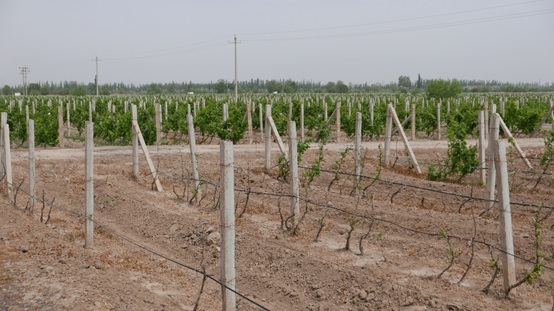Researchers from the Institute of Botany, Chinese Academy of Sciences (IBCAS), together with the domestic and foreign collaborators, released the chromosome level genome of Vitis amurensis and put new insights into cold and freezing tolerance of grapevine.
V. amurensis is a wild grape species widely spread in East Asia. It has been seemed as an ideal plant material for grape cold resistance breeding, as it can survive at extremely low temperature below -30°C. Although V. amurensis has been studied for several decades, its cold tolerance mechanism is still not clear.
The researchers have drawn a high-quality fine map of V. amurensis, which has laid a foundation for the study of cold tolerance mechanism of grapevine.
They found that there might exist a different regulation mechanism between chilling and freezing responses in grape. Genes such as MYB14 and CBF3 played an important role in the early response to chilling injury, while carbohydrate metabolism might also be one of the important factors affecting freezing injury in grape.
In addition, GWAS and transcriptomic analysis showed that the expression level of PGK, a key gene in glycolysis pathway, was important for dormant buds of grape survival in the severe winter.
According to the genome, a PAT1 gene, a member of the GRAS family, was cloned from V. amurensis. It was found that PAT1 protein could activate the expression of LIPOXYGENASE 3 gene by interacting with INDETERMINATE-DOMAIN 3 protein, thus promote the biosynthesis of jasmonic acid (JA) which improve the cold tolerance of grape. These findings revealed that PAT1 gene may play an important role in cold tolerance of grapevine.
“The Shanputao genome sequence not only represents a valuable resource for grape breeders, but also is important for clarifying the molecular mechanisms involved in cold tolerance. Based on the genome sequence, we indeed found the pivotal role of PAT1 in the cold stress response in grape by regulating JA biosynthesis. This could be a very interesting direction for enhancing grape cold resistance in breeding.” said Prof. LIANG Zhenchang, the correspondence author of the study.
The above studied entitled “The genome of Shanputao (V. amurensis) provides a new insight into cold tolerance of grapevine” and “GRAS-domain transcription factor PAT1 regulates jasmonic acid biosynthesis in grape cold stress response” have been published online in The Plant Journal and Plant Physiology, respectively.

The contrast of two varieties after a cold winter in Ningxia (Image by FAN Peige). The lower is Cabernet Sauvignon (V. vinifera), the upper is Beihong (V. vinifera x V. amurensis)
Article Link:
https://onlinelibrary.wiley.com/doi/10.1111/tpj.15127
https://academic.oup.com/plphys/advance-article/doi/10.1093/plphys/kiab142/6180079?searchresult=1
Contact:
Email:zl249@ibcas.ac.cn
Institute of Botany, Chinese Academy of Sciences
Researchers from the Institute of Botany, Chinese Academy of Sciences (IBCAS), together with the domestic and foreign collaborators, released the chromosome level genome of Vitis amurensis and put new insights into cold and freezing tolerance of grapevine.
V. amurensis is a wild grape species widely spread in East Asia. It has been seemed as an ideal plant material for grape cold resistance breeding, as it can survive at extremely low temperature below -30°C. Although V. amurensis has been studied for several decades, its cold tolerance mechanism is still not clear.
The researchers have drawn a high-quality fine map of V. amurensis, which has laid a foundation for the study of cold tolerance mechanism of grapevine.
They found that there might exist a different regulation mechanism between chilling and freezing responses in grape. Genes such as MYB14 and CBF3 played an important role in the early response to chilling injury, while carbohydrate metabolism might also be one of the important factors affecting freezing injury in grape.
In addition, GWAS and transcriptomic analysis showed that the expression level of PGK, a key gene in glycolysis pathway, was important for dormant buds of grape survival in the severe winter.
According to the genome, a PAT1 gene, a member of the GRAS family, was cloned from V. amurensis. It was found that PAT1 protein could activate the expression of LIPOXYGENASE 3 gene by interacting with INDETERMINATE-DOMAIN 3 protein, thus promote the biosynthesis of jasmonic acid (JA) which improve the cold tolerance of grape. These findings revealed that PAT1 gene may play an important role in cold tolerance of grapevine.
“The Shanputao genome sequence not only represents a valuable resource for grape breeders, but also is important for clarifying the molecular mechanisms involved in cold tolerance. Based on the genome sequence, we indeed found the pivotal role of PAT1 in the cold stress response in grape by regulating JA biosynthesis. This could be a very interesting direction for enhancing grape cold resistance in breeding.” said Prof. LIANG Zhenchang, the correspondence author of the study.
The above studied entitled “The genome of Shanputao (V. amurensis) provides a new insight into cold tolerance of grapevine” and “GRAS-domain transcription factor PAT1 regulates jasmonic acid biosynthesis in grape cold stress response” have been published online in The Plant Journal and Plant Physiology, respectively.

The contrast of two varieties after a cold winter in Ningxia (Image by FAN Peige). The lower is Cabernet Sauvignon (V. vinifera), the upper is Beihong (V. vinifera x V. amurensis)
Article Link:
https://onlinelibrary.wiley.com/doi/10.1111/tpj.15127
https://academic.oup.com/plphys/advance-article/doi/10.1093/plphys/kiab142/6180079?searchresult=1
Contact:
Email:zl249@ibcas.ac.cn
Institute of Botany, Chinese Academy of Sciences
